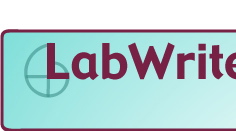Special
Teaching Tools:
Descriptive Labs
Partial Lab Reports
Designing Lab Experiments
Graphing Resources
Sample
Lab Reports
Teaching Strategies:
Basic Strategies
Collaborative Work
Peer review
E-Learning Systems
Special Teaching
Tools
Descriptive
Labs
The default lab report in LabWrite is the hypothetical
lab, one that is based on establishing and testing a hypothesis. However,
there are many labs in which a hypothesis is not appropriate. We call
these descriptive labs: the focus is on following a lab procedure and
describing the results. Students may be working on lab techniques, determining
an unknown, collecting observations on specimens, etc. In lieu of establishing
a hypothesis, LabWrite directs students doing a descriptive lab to ask
to questions about the lab in the Introduction and to return to those
questions in the Discussion.
LabWrite provides the entire sequence of stages
for descriptive labs, PreLab, InLab, PostLab, and LabCheck. These guides
can be found on the homepages for each LabWrite stage.
Partial
Lab Reports
Some lab instructors ask their students to write parts of a lab report
instead of a complete report. For instance, students may do the Results
in the first lab and Methods and Results in the second lab and so on until
they build up to a complete lab report. LabWrite offers a guide to writing
lab reports in this way, too.
The key to the LabWrite
approach to partial reports, though, is that students write a one-sentence
summary of the parts of the report that they are not asked to write in
full. This helps students to develop a good understanding of the scientific
logic of the whole lab report even if they are asked to write only a partial
report. By the time students write their first complete lab report, they
are already familiar with the full structure of it.
See Partial
Laboratory Report on the PostLab homepage and under Additional Resources
at the Resources Homepage.
Designing
Lab Experiments
There have been more and more calls recently for allowing students to
participate more fully in science by designing their own experiments.
Some labs have students build up to an experimental design at the end
of the semester or quarter; in other labs, particularly more advanced
labs, students design experiments for every lab.
LabWrite encourages student-designed experiments
by providing a set of questions that leads students through the critical
issues of the scientific method. Each question builds on the responses
to the previous questions, from defining the problem to establishing
a hypothesis to designing an experiment to test the hypothesis. Students
can also find a sample experimental design that they can follow for
each of the questions. If your course allows for students to design
their own experiments, students can use LabWrite and write their lab
reports by choosing Designing Your Own Lab Experiment from each of the
LabWrite stages--PreLab, InLab, PostLab, LabCheck--at their Homepages.
Graphing
Resources
Oftentimes lab instructors don’t have time
to provide the extensive help some students need in using Excel and
making graphs. LabWrite’s Graphing Resources fills that need.
It provides a user-friendly Excel tutorial and detailed and accessible
guides to creating many kinds of graphs. It has guides that lead students
through decision trees for determining whether to use tables or graphs
and what kinds of graphs are appropriate to the data. It provides a
tutorial in designing tables. It even has guides on significant digits
and error bars.
Check out these student
guides at Graphing Resources.
Sample
Lab Reports
Many students, particularly those in introductory
labs, ask if they can see a good lab report so that they have a better
idea of what is expected of them. LabWrite makes a variety of reports
available, each one presented in a straight version and in an annotated
version. These sample labs act as valuable learning tools because students
can see explicitly how the step-by-step instruction in the LabWrite
PostLab guide has been applied to a completed lab report.
There are lab reports from a variety of fields.
There are both hypothetical and descriptive reports and reports using
quantitative and qualitative data. You can find Sample
Lab Reports under Additional Resources in the Resources homepage.
Teaching Strategies
Basic
Strategies
Class
discussion: This relatively narrow mode of instruction,
which combines teacher presentation and student interaction, is useful
when there is a concept that students need to learn. There are two basic
approaches to leading a class discussion: (1) to present the concept and
then ask questions to generate a conversation that clarifies and reinforces
the concept and (2) to begin with questions designed to spark a conversation
that leads student to an understanding of the concept, which the teacher
clarifies and reinforces at the end.
Brainstorming: This more open-ended mode of
instruction is appropriate to situations in which there may be no "right"
answers. The point is to promote student interaction about a topic by
encouraging them to generate many and various responses, delaying judgment
on the quality of the responses. Those ideas may be recorded on a blank
transparency or on the board and used to find agreement among students
or to guide them toward an understanding of an issue.
Small-group activity:
This is the most open-ended of these modes of instruction, allowing
students to learn from and with each other by engaging in brief or extended
assigned projects. The entire class is divided into several small groups
(group size may depend on the physical structure of the classroom as
well as on the number of students) and each group gets a specific task
they have to complete in a given amount of time. Usually, groups will
summarize their work and report their experience to the entire class.
Click here for advice on managing small
groups.
|




